Effectively using brush screens in your offense
The brush screen is more popular in the college game and has been modified from its original form: the downscreen. With a brush screen, the cutter breaks from a screen that is in motion and stays in motion. There is no jump-stopping by the screener before the teammate makes his or her cut.
With a brush screen, the screener cuts away from the basketball and acts as the initial cutter, while the second player times the cut toward the ball and through the lane to brush the defender off of the initial cutter. The second screener, in some instances, then sets a more traditional screen for another teammate to be a secondary receiver.
The success of this type of screen is based on three components. First, the cutter must make brushing contact with the screener to prevent the defender from staying close. Second, there should be perfect timing between the screener and the cutter. And third, teams can gain an advantage by setting “big-on-small” or “small-on-big” screens. These screens, with different sized players, discourage defensive switching and can uncover weaknesses in defenders.
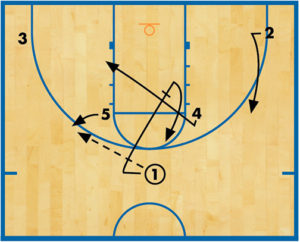 DIAGRAM 1: This illustrates an entry from the “horns set.” It can be executed toward either side, making it dangerous because of its unpredictability. 1 passes to 5, who has stepped out slightly from his initial location. 1 immediately starts to make a diagonal cut toward the basket. 4 uses the proper timing and scrapes off 1’s backside before cutting diagonally across the lane, looking for a quick inside pass from 5 and ending up on the new ball-side mid-post area. This small-on-big screen complicates the defensive action and strategy.
DIAGRAM 1: This illustrates an entry from the “horns set.” It can be executed toward either side, making it dangerous because of its unpredictability. 1 passes to 5, who has stepped out slightly from his initial location. 1 immediately starts to make a diagonal cut toward the basket. 4 uses the proper timing and scrapes off 1’s backside before cutting diagonally across the lane, looking for a quick inside pass from 5 and ending up on the new ball-side mid-post area. This small-on-big screen complicates the defensive action and strategy.
After brush-screening 4’s defender, 1 returns to the top of the key. At the same time, 2 breaks from the deep corner to the wing area near the free-throw-line extended. This action not only presents 5 with another perimeter scoring threat (2), but it also helps eliminate any possible interior support defense.
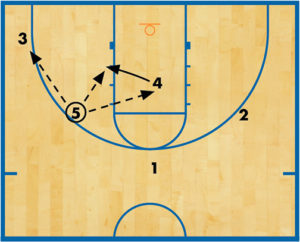 DIAGRAM 2: 5 looks to hit 4 on his cut across the lane, and he also has 3 spotted up in the deep corner, available for a quick catch-and-shoot, jump shot or a better passing angle to deliver the ball to 4 down low.
DIAGRAM 2: 5 looks to hit 4 on his cut across the lane, and he also has 3 spotted up in the deep corner, available for a quick catch-and-shoot, jump shot or a better passing angle to deliver the ball to 4 down low.
The next three diagrams show the different types of offensive action that can be executed when 5 turns down all passes except the reverse pass to 1 at the top of the key.
 DIAGRAM 3: 5 looks to hit 4 on the brush screen but does not make the inside pass to 4 or 3, instead reversing the ball to 1. From the ball-side mid-post area, 4 seals off the defender and ducks into the middle of the lane, looking for the pass from 1 or 2.
DIAGRAM 3: 5 looks to hit 4 on the brush screen but does not make the inside pass to 4 or 3, instead reversing the ball to 1. From the ball-side mid-post area, 4 seals off the defender and ducks into the middle of the lane, looking for the pass from 1 or 2.
As soon as 1 swings the ball to 2 on the original weak-side, 1 and 5 stagger-screen for 3 to cut from the deep corner to the top of the key for a good look at a 3-point shot. This action not only produces shot opportunities for 3, but it also isolates 4’s defender by eliminating any interior support defense, giving 4 another high-percentage shot opportunity. If this action does not produce a shot, it positions all five players into the three-out, two-in spot-ups to continue attacking.
 DIAGRAM 4: 5 reverses the ball to 1, and 1 swings the ball to 2. As 2 receives 1’s pass, 5 makes a shuffle cut off 4’s backscreen and looks for 2’s inside pass. If 5 does not receive 2’s pass, 5 continues across the lane to the new ball-side mid-post area.
DIAGRAM 4: 5 reverses the ball to 1, and 1 swings the ball to 2. As 2 receives 1’s pass, 5 makes a shuffle cut off 4’s backscreen and looks for 2’s inside pass. If 5 does not receive 2’s pass, 5 continues across the lane to the new ball-side mid-post area.
Both 1 and 4 turn to stagger-screen for 3. The screen again gives 2 the opportunity to hit 3 at the top of the key for a 3-pointer and eliminates help-side defense for 5 to be the new offensive post player to isolate his or her defender. If no shots are taken, the next phase of the offense from three-out, two-in spot-ups can begin.
 DIAGRAM 5: This illustrates a form of a second brush screen along the baseline. The timing of this second screen must have 5 look to hit 3 on the cut and, if not open, to quickly reverse the ball to 1 at the top of the key. 3 cuts closely off 4 and across the lane to the new ball-side mid-post area.
DIAGRAM 5: This illustrates a form of a second brush screen along the baseline. The timing of this second screen must have 5 look to hit 3 on the cut and, if not open, to quickly reverse the ball to 1 at the top of the key. 3 cuts closely off 4 and across the lane to the new ball-side mid-post area.
5 or 1 can look to hit 3 on his cut across the lane before 3 posts up on the new ball-side mid-post. 1 could pass to 2 and then small-on-big brush screen the screener (4). This screen-the-screener action is more difficult to defend when it’s initiated and concluded with brush screens. Also, the screen by 1 and 4 helps eliminate interior support so that 3 can isolate their defender on the ball-side block.
If this offensive action does not produce a shot, all five players have re-positioned themselves in three-out, two-in spot-ups for the offense’s next to continue.
 DIAGRAM 6: This play is from the “twins set.” Because of the alignment, this play can be initiated to either side of the floor, making it less predictable and more difficult to defend.
DIAGRAM 6: This play is from the “twins set.” Because of the alignment, this play can be initiated to either side of the floor, making it less predictable and more difficult to defend.
Both 3 and 2 walk their defender up the lane before exploding to the free-throw-line-extended on their respective sides of the court. 1 passes to 2 on the right side of the floor. 1 starts to step toward the receiver before diagonally cutting just inside the newly declared weak-side elbow. 5 uses 1’s small-on-big brush screen, contacting 1 as 5 diagonally slash-cuts to the new ball-side mid-post area.
With 4 remaining at the high post, 5 at the ball-side mid-post area, 1 at the new weak-side wing area and 3 rotating to the top of the key, there is no support for 5’s defender. Whatever method 5’s defender uses to deny the ball, 5 should have a solution.
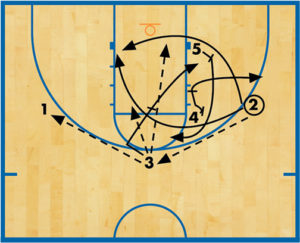 DIAGRAM 7: If 2 reverses the ball to 3 at the top of the key, 2 could shuffle-cut low off 5’s backscreen or cut high off 4’s backscreen and look for a return pass in the lane from 3 or 1. After 3 swings the ball to 1, 3 and 4 stagger-screen for 5 to break to the top of the key. This three-man action on the weak-side eliminates adequate help-side defense. If no shots are produced by the backscreens and shuffle-cut combination, and no shot comes from the staggered screen, all players are repositioned in three-out, two-in spot-ups for the next phase to begin.
DIAGRAM 7: If 2 reverses the ball to 3 at the top of the key, 2 could shuffle-cut low off 5’s backscreen or cut high off 4’s backscreen and look for a return pass in the lane from 3 or 1. After 3 swings the ball to 1, 3 and 4 stagger-screen for 5 to break to the top of the key. This three-man action on the weak-side eliminates adequate help-side defense. If no shots are produced by the backscreens and shuffle-cut combination, and no shot comes from the staggered screen, all players are repositioned in three-out, two-in spot-ups for the next phase to begin.
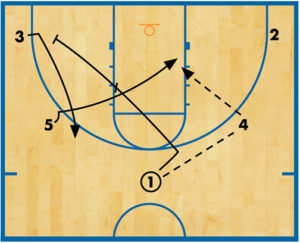 DIAGRAM 8: This play is called “one wide.” 1 makes the pass to either 5 on the left side of the court or 4 on the right side. 1 make the pass to 4, follow the pass for two steps and diagonally cuts to the new weak-side elbow. 5 times the cut and “nicks” the backside of 1 as 1 moves to set a second screen for 3. 5 uses 1’s small-on-big brush screen and slash-cuts across the lane to post up on the new ball-side mid-post area. 3 then cuts off 1’s brush screen while 1 and 3 stay wide on the weak side, which discourages any interior support that 5’s defender would need to adequately deny 5 the ball. If no shots are produced, offensive players are in wide four-out, one-in spot-ups for the offense to continue attacking.
DIAGRAM 8: This play is called “one wide.” 1 makes the pass to either 5 on the left side of the court or 4 on the right side. 1 make the pass to 4, follow the pass for two steps and diagonally cuts to the new weak-side elbow. 5 times the cut and “nicks” the backside of 1 as 1 moves to set a second screen for 3. 5 uses 1’s small-on-big brush screen and slash-cuts across the lane to post up on the new ball-side mid-post area. 3 then cuts off 1’s brush screen while 1 and 3 stay wide on the weak side, which discourages any interior support that 5’s defender would need to adequately deny 5 the ball. If no shots are produced, offensive players are in wide four-out, one-in spot-ups for the offense to continue attacking.
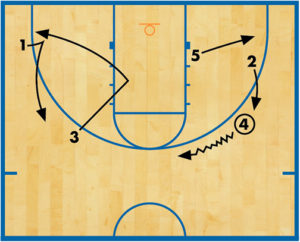 DIAGRAM 9: If 4 did not make the inside pass to his or her teammate in Diagram 8 and elected not to pass to 2 in the deep corner, 4 could have chosen to dribble the ball to the center of the court. 3 then should make a hard backdoor cut to the basket and, if he does not receive the pass, 3 should then empty out to the deep corner on the same side of the floor while 1 breaks up to the high wing area. From the opposite deep corner area, 2 rotates up to replace the dribbler (4) and 5 steps out of the post area to the deep corner to replace 2. 1 and 2 are now the wings with 3 and 5 stretching the defense horizontally and vertically in their respective deep corners. 4 can stop the dribble and make a pass similar to how 1 initiated the offense.
DIAGRAM 9: If 4 did not make the inside pass to his or her teammate in Diagram 8 and elected not to pass to 2 in the deep corner, 4 could have chosen to dribble the ball to the center of the court. 3 then should make a hard backdoor cut to the basket and, if he does not receive the pass, 3 should then empty out to the deep corner on the same side of the floor while 1 breaks up to the high wing area. From the opposite deep corner area, 2 rotates up to replace the dribbler (4) and 5 steps out of the post area to the deep corner to replace 2. 1 and 2 are now the wings with 3 and 5 stretching the defense horizontally and vertically in their respective deep corners. 4 can stop the dribble and make a pass similar to how 1 initiated the offense.
 DIAGRAM 10: 4 makes the pass to 1 and sets a brush-screen inside the elbow for 2 to make a slash-cut to the new ball-side block area as 5 rotates to fill 2’s now empty wing area. This play could remain as an offensive continuity that allows the players to keep possession of the ball while constantly attacking, challenging and fatiguing the defense.
DIAGRAM 10: 4 makes the pass to 1 and sets a brush-screen inside the elbow for 2 to make a slash-cut to the new ball-side block area as 5 rotates to fill 2’s now empty wing area. This play could remain as an offensive continuity that allows the players to keep possession of the ball while constantly attacking, challenging and fatiguing the defense.
Creative coaches can devise different plays from other offensive sets that fit their own personnel and philosophy with using brush screens. Combining the small-on-big or big-on-small action compounds the problems for even the best man-to-man defenses.
— John Kimble coached basketball for 23 years in Illinois and Florida at the college and high school levels, accumulating more than 340 victories. He has authored five coaching books.









